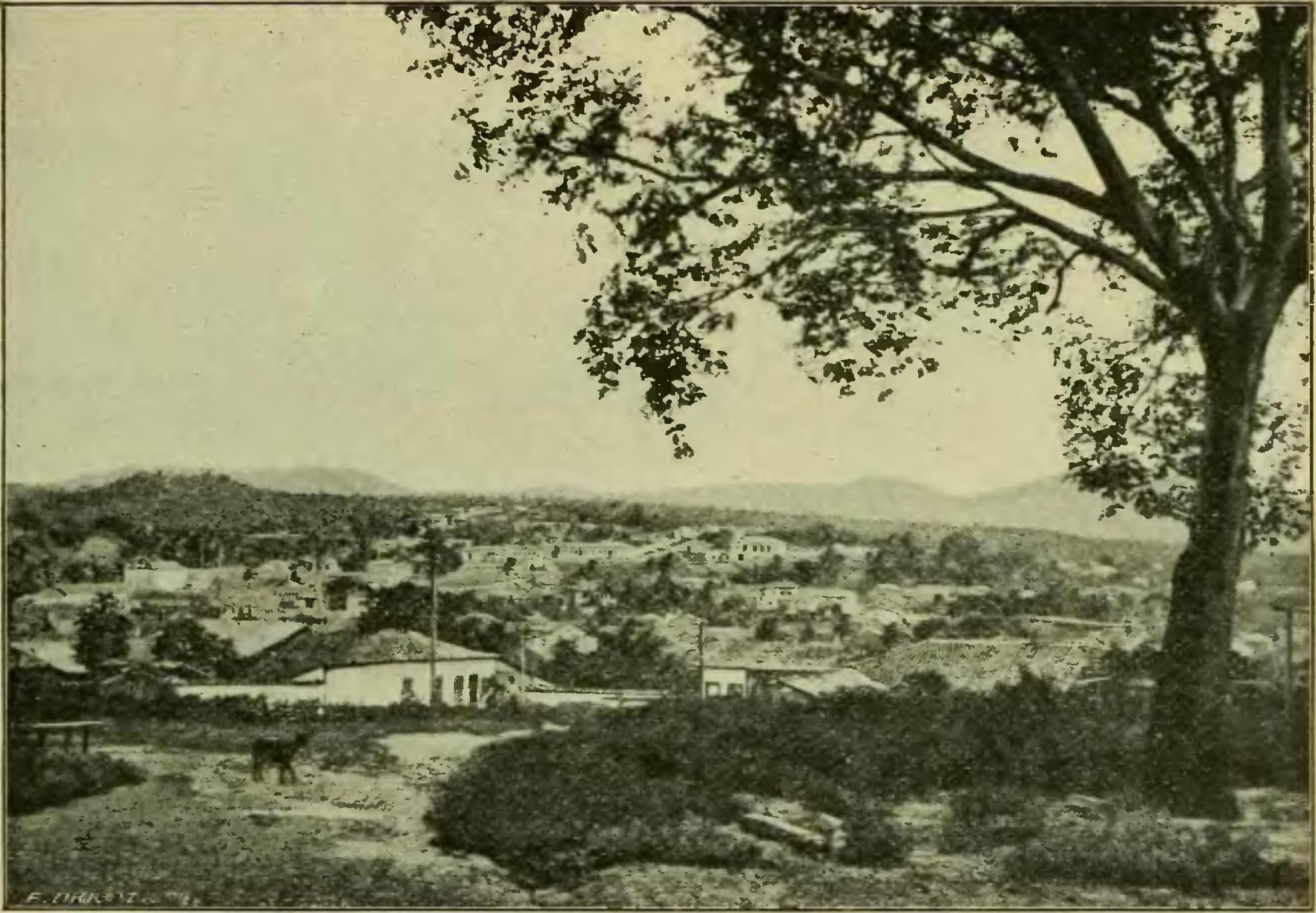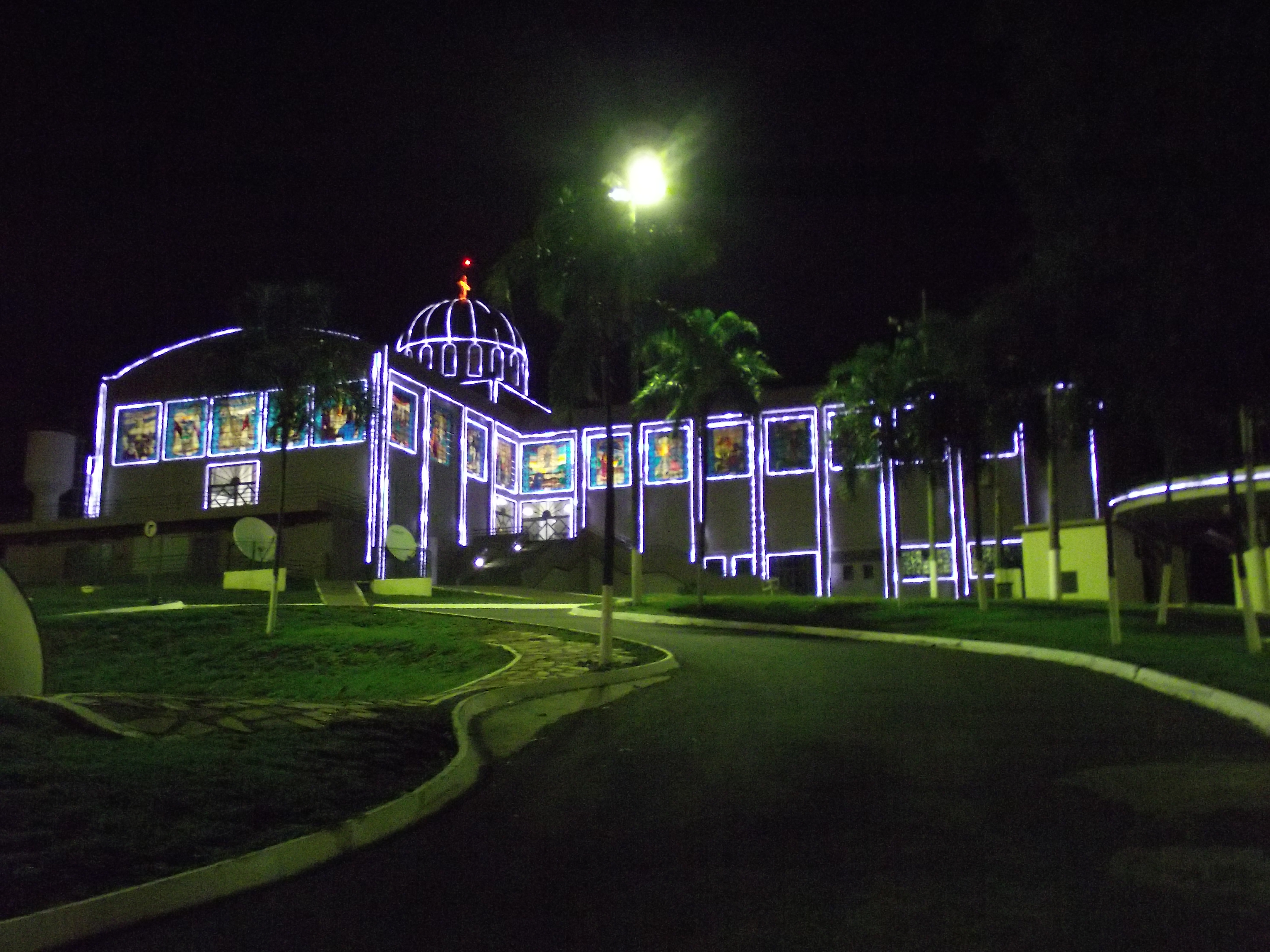|
São Luís De Montes Belos
São Luís de Montes Belos (also written São Luis de Montes Belos) is a municipality in the State of Goiás, Brazil. Location It is located in the Anicuns Microregion, 123 kilometers from the state capital, Goiânia, to which it is connected by highway GO-060. It is bounded by the following municipalities: Sanclerlândia, Adelândia, Turvânia, Firminópolis, Aurilândia, Sanclerlândia and Córrego do Ouro. The distance to Goiânia is 129 km. Highway communications are made by GO-060 / Trindade / Nazário / Turvânia / Firminópolis. Demographics The population density was 32.42 inhabitants/km2 (2007). The urban population was 23,439 and the rural population was 3,345 (2007). Geography The average elevation is 630 meters above sea level and most of the land is flat or hilly. There are many rivers, the most important being the Fartura, Cerrado, and São Domingos. The main streams are the Santana, Santa Rosa, São Manoel and Diamantina. The climate of the region is ho ... [...More Info...] [...Related Items...] OR: [Wikipedia] [Google] [Baidu] |
Municipalities Of Brazil
The municipalities of Brazil ( pt, municípios do Brasil) are administrative divisions of the states of Brazil, Brazilian states. Brazil currently has 5,570 municipalities, which, given the 2019 population estimate of 210,147,125, makes an average municipality population of 37,728 inhabitants. The average state in Brazil has 214 municipalities. Roraima is the least subdivided state, with 15 municipalities, while Minas Gerais is the most subdivided state, with 853. The Federal District (Brazil), Federal District cannot be divided into Municipality, municipalities, which is why its territory is composed of several Administrative regions of the Federal District (Brazil), administrative regions. These regions are directly managed by the government of the Federal District, which exercises constitutional and legal powers that are equivalent to those of the Federated state, states, as well as those of the Municipality, municipalities, thus simultaneously assuming all the obligations a ... [...More Info...] [...Related Items...] OR: [Wikipedia] [Google] [Baidu] |
Goiânia
Goiânia (; ) is the capital and largest city of the Brazilian state of Goiás. With a population of 1,536,097, it is the second-largest city in the Central-West Region and the 10th-largest in the country. Its metropolitan area has a population of 2,654,860, making it the 12th-largest in Brazil. With an area of approximately , it has a continuous geography with few hills and lowlands, with flat lands in most of its territory, especially the Meia Ponte River, in addition to Botafogo and Capim Puba streams. Goiânia has its origins as a planned city, founded on October 24, 1933 by then Governor Pedro Ludovico to serve as the new state capital and administrative center. Before this, the state capital was the town of Goiás. It is the second most populous city in the Central-West Region, only surpassed by the country's capital Brasília, located about from Goiânia. The city is an important economic hub of the region and is considered a strategic center for such areas as industry, ... [...More Info...] [...Related Items...] OR: [Wikipedia] [Google] [Baidu] |
List Of Municipalities In Goiás
This is a list of the municipalities in the state of Goiás (GO), in the Central-West Region of Brazil. Goiás is divided into 246 municipalities, which are grouped into 18 microregions, which are grouped into 5 mesoregions. Ordered by regions Ordered by population List of municipalities in Goiás by population, in descending order, based on estimates from IBGE for 1 July 2005. More than 500,000 inhabitants More than 100,000 inhabitants More than 50,000 inhabitants More than 25,000 inhabitants More than 10,000 inhabitants More than 5,000 inhabitants Fewer than 5,000 inhabitants Ordered by area and population This is a list of municipalities in the state of Goiás, Brazil. Population figures are estimates from 2005. Area figures are from 2002. See also *Geography of Brazil *List of cities in Brazil Brazil has a high level of urbanization with 87.8% of the population residing in Urban area, urban and Metropolitan area, metropolitan areas. T ... [...More Info...] [...Related Items...] OR: [Wikipedia] [Google] [Baidu] |
Goiás, Goiás
Goiás (also known as Goiás Velho, Old Goiás) is a municipality in the state of Goiás in Brazil. Its population was 22,381 (2020 est.) and its area is 3,108 km2. It is the former capital of the state and preserves much of its colonial heritage. In 2002, it became a UNESCO World Heritage Site. World Heritage Site It used to be the old state capital of Goiás up until 1937 when the government seat was transferred to the then-recently built Goiânia. It was founded by the famed Bandeirante explorer Bartolomeu Bueno da Silva, nicknamed the ''Anhangüera'', and was called in colonial times Vila Boa de Goyaz ("Good Village of Goyaz" in archaic Portuguese). Given its historical importance, the historical center of Goiás was included on the UNESCO's World Heritage list in 2001. Location Municipal boundaries: *North: Faina *South: Mossâmedes *East: Itaberaí *West: Itapirapuã and Matrinchã *Districts: Calcilândia, Buenolândia, Davidópolis, São João e Uvá. *Povoado (vill ... [...More Info...] [...Related Items...] OR: [Wikipedia] [Google] [Baidu] |
Rei Ayanami
is a fictional character from the anime ''Neon Genesis Evangelion'', created by Gainax. She is the First Child and pilot of a giant mecha named Evangelion Unit 00. At the beginning of the series, Rei is an enigmatic figure whose unusual behavior astonishes her peers. As the series progresses, she becomes more involved with the people around her, particularly her classmate and fellow Eva pilot, Shinji Ikari. Rei appears in the franchise's animated feature films and related media, video games, the original net animation '' Petit Eva: Evangelion@School'', the ''Rebuild of Evangelion'' films, and the manga adaptation by Yoshiyuki Sadamoto. Hideaki Anno, director of the animated series, conceived her as a representation of his unconscious. He was also influenced by his readings on psychology, in particular on Freudian psychoanalysis, taking inspiration from Freud's theories on the Oedipus complex. Other influences for its creation include earlier works by Gainax staff members, such ... [...More Info...] [...Related Items...] OR: [Wikipedia] [Google] [Baidu] |
Gir Cattle
The Gir or Gyr is one of the principal Zebu breeds originating in India. It has been used locally in the improvement of other breeds including the Red Sindhi and the Sahiwal. It was also one of the breeds used in the development of the Brahman breed in North America. In Brazil and other South American countries the Gir is used frequently because, as a ''Bos indicus'' breed, it is resistant to hot temperatures and tropical diseases. It is well known for its milk producing qualities and is often bred with Friesian cows to make the Girolando breed. The Gir is distinctive in appearance, typically having a rounded and domed forehead (being the only ultraconvex breed in the world), long pendulous ears and horns which spiral out and back. Gir are generally mottled with the colour ranging from red through yellow to white, black being the only unacceptable colour. They originated in west India in the state of Gujarat and have since spread to neighbouring Maharashtra and Rajasthan. ... [...More Info...] [...Related Items...] OR: [Wikipedia] [Google] [Baidu] |
Nazário
Nazário is a municipality in eastern Goiás state, Brazil. Location Nazário is located 74 km. west of the state capital, Goiânia a few kilometers west of the Rio dos Bois, a major tributary of the Paranaíba River. The regional center, Anicuns, is 21 km to the northwest. Highway connections from Goiânia are made by state highway BR-069 west from Goiânia, through Trindade, Santa Bárbara de Goiás, and then 12 kilometers west to Nazário. Neighboring municipalities are Turvânia, Anicuns, Avelinópolis, and Santa Bárbara de Goiás Demographics In 2007 there were 6,702 people living in the urban area and 521 living in the rural area. The population has increased by about 1,000 people since 1980. Between 2000 and 2007 the geometric population growth rate was 1.23.%. The economy The economy was based on agriculture, cattle raising, services, and a small number of modest transformation industries. There was 1 meat-packing plant—Gelnex Indústria e Comércio ... [...More Info...] [...Related Items...] OR: [Wikipedia] [Google] [Baidu] |
Trindade, Goiás
Trindade () is a city and municipality in Goiás state, Brazil. It is famous for the religious celebrations held there in July and is now the third most important pilgrimage site in Brazil. On the west side of the city is a purpose-built raceway where, in 2014, the city hosted a MotoCross World Championship, Grand Prix race. Trindade is part of the Goiânia Microregion, which has over one million six hundred thousand inhabitants. It is located approximately 30 km. west of Goiânia, to which it is connected by a four-lane highway, GO-060. Origin of the City Although Trindade became a city in 1943, its origins go back to 1840, when, according to local folklore, in a small village called Barro Preto, Constantino Xavier and his wife Ana Rosa found in their fields a small clay medallion showing the Holy Trinity crowning the Virgin Mary. Soon a palm covered chapel was raised to be later replaced by a mortar chapel covered with tiles. Lands were donated by local farmers and a reli ... [...More Info...] [...Related Items...] OR: [Wikipedia] [Google] [Baidu] |
Córrego Do Ouro
Córrego do Ouro is a municipality in eastern Goiás state, Brazil. Location and Highway Connections Córrego do Ouro is located in the Iporá Microregion west of the state capital, Goiânia. It is 45 km. northwest of São Luís de Montes Belos, the largest town in the region. Goiânia lies at a distance of 171 km. Highway connections from Goiânia were made by GO-060 / Trindade / Claudinápolis (district) / GO-326 / Anicuns / GO-222 / GO-326 / Sanclerlândia / Buriti de Goiás / GO-518Seplan Neighboring municipalities: Moiporá, Israelândia, Fazenda Nova, Novo Brasil, Buriti de Goiás, and Adelândia Demographics *Population in 1980: 4,367 *Population in 2007: 2,633 *Urban population: 1,571 *Rural population: 1,062 *Population growth rate: -1.77% The economy The main economic activities were cattle raising (64,200 in 2006) and agriculture. Main crops were rice, bananas, and corn. There was one dairy: Laticínios Farlat - Indústria e Comércio Ltda (2007) ... [...More Info...] [...Related Items...] OR: [Wikipedia] [Google] [Baidu] |
Aurilândia
Aurilândia is a municipality in eastern Goiás state, Brazil. Location The distance to the state capital is 146 km. while the distance to the main regional center São Luís de Montes Belos is 23 km. Highway connections from Goiânia are made by state highway BR-069 west from Goiânia, through Trindade, São Luís de Montes Belos, and then 23 kilometers south to Aurilândia. Neighboring municipalities are São Luís de Montes Belos, Firminópolis, São João da Paraúna, and Paraúna. Demographics *Population density: 6,58 inhabitants/km2 (2007) *Population growth rate: -1.93% 1996/2007 *Population in 1980: 4,953 *Population in 2007: 3,719 *Urban population: 2,762 Economy The main economic activities are cattle raising, agriculture, commerce, and small transformation industries. Public administration is the largest employer. There is a large informal economy. There were 61,200 head of cattle (6,000 milking cows) in 2006. The main agricultural products were banan ... [...More Info...] [...Related Items...] OR: [Wikipedia] [Google] [Baidu] |
Firminópolis
Firminópolis is a municipality in eastern Goiás state, Brazil. Location and connections *Distance to São Luís de Montes Belos: 9 km. Highway connections with Goiânia are made by state highway BR-069 west from Goiânia, through Trindade, Santa Bárbara de Goiás, Turvânia, and then 19 kilometers west to Firminópolis. Neighboring municipalities are Turvânia, Aurilândia, and Turvânia. Demographic data *Population growth rate 2000/2007: 0.53% *Urban population in 2007: 8,212 *Rural population in 2007: 2,074 Economic data The main economic activities were small transformation industries, goods and services, and agricultural production. There were 02 banking institutions: Banco do Brasil S.A. - Banco Itaú S.A. (08/2007) There was 01 dairy: Manoel Pereira Peixoto (05/2006). The cattle herd had 55,0000 head (2006) and the main crops were rice, corn, soybeans, manioc, hearts of palm, and bananas. Education and health *Literacy rate: 84.1% *Infant mo ... [...More Info...] [...Related Items...] OR: [Wikipedia] [Google] [Baidu] |
Turvânia
Turvânia is a municipality in eastern Goiás state, Brazil. Location Turvânia is located west of Goiânia, east of São Luís de Montes Belos. Highway connections from Goiânia are made by state highway BR-069 west from Goiânia, through Trindade, Santa Bárbara de Goiás, and then 50 kilometers west to Turvânia. Neighboring municipalities are Firminópolis, São Luís de Montes Belos, Adelândia, Nazário and Anicuns. Demographics The population density was 10.51/km2 (27.2/mi2) (2007). The urban population was 4,036 (2007) and the rural population was 926. The economy The economy is based on subsistence agriculture, cattle raising, services, public administration, and small transformation industries. There was one dairy in 2007. The cattle herd had 65,000 (2006). The main crops were rice, bananas, sugarcane (2,200 hectares; 5,400 ac), beans, manioc, corn, tomatoes, and soybeans. Health and education The adult literacy rate was 85.5% (2000) (the national average w ... [...More Info...] [...Related Items...] OR: [Wikipedia] [Google] [Baidu] |



